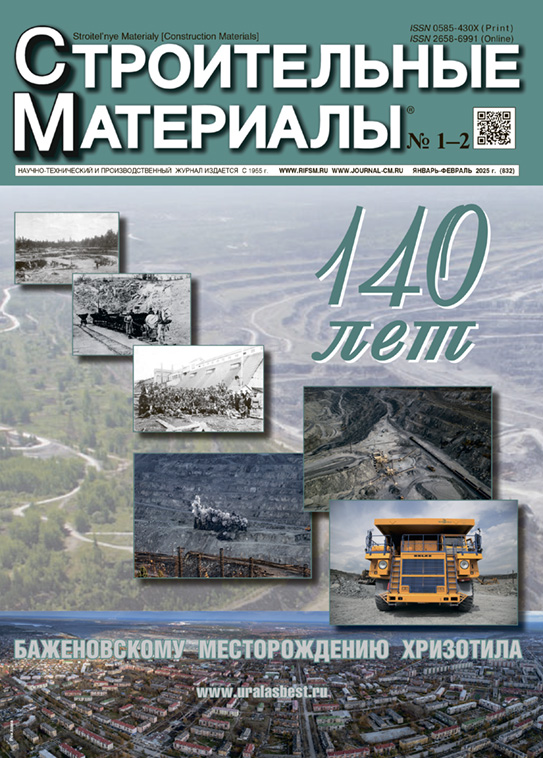Research of the physicochemical and mechanical properties of composite materials based on lignosulfonates
- Autores: Zhulanova A.E.1, Glushankova I.S.1
-
Afiliações:
- Perm National Research Polytechnic University
- Edição: Nº 1-2 (2025)
- Páginas: 66-71
- Seção: Статьи
- URL: https://rjeid.com/0585-430X/article/view/677200
- DOI: https://doi.org/10.31659/0585-430X-2025-832-1-2-66-71
- ID: 677200
Citar
Texto integral
Resumo
The increasing pace of construction in Russia and increasing environmental requirements for building materials lead to the need to search for new solutions for the creation of unique materials and the involvement of additional resources. The analysis of scientific and technical literature and laboratory studies have shown that lignosulfonates can be one of the promising sources of raw materials for the production of composite building materials. In this regard, the work investigated and substantiated a method for producing composite materials based on lignosulfonates. It was found that in the obtained compositions, lignosulfonates act as both a hardener and a dispersed filler. Thermogravimetry proved that the obtained compositions are thermally stable. The results of the study of the physicochemical and mechanical properties of the obtained samples showed that lignoepoxy composite materials can be an alternative replacement for known industrial analogues.
Palavras-chave
Texto integral
Sobre autores
A. Zhulanova
Perm National Research Polytechnic University
Autor responsável pela correspondência
Email: 79194776224@yandex.ru
Candidate of Sciences (Engineering)
Rússia, 614990, Perm, Komsomolsky Prospekt, 29I. Glushankova
Perm National Research Polytechnic University
Email: irina_chem@mail.ru
Doctor of Sciences (Engineering)
Rússia, 614990, Perm, Komsomolsky Prospekt, 29Bibliografia
- Damien Breilly, Sami Fadlallah, Vincent Froidevaux, Antoine Colas, Florent Allais. Origin and industrial applications of lignosulfonates with a focus on their use as superplasticizers in concrete. Construction and Building Materials. 2021. Vol. 301. 124065. https://doi.org/10.1016/j.conbuildmat.2021.124065
- Flatt R., Schober I. Understanding the rheology of concrete. Woodhead Publishing Limited. 2012. 364 r.
- Li K., Geng X. Formaldehyde-free wood adhesives from decayed wood. Macromolecular Rapid Communications. 2005. Vol. 26, pp. 529–532. https://doi.org/10.1002/marc.200400594
- Jang Y., Huang J., Li K. A new formaldehyde-free wood adhesive from renewable materials. International Journal Adhesion and Adhesives. 2011. Vol. 31, pp. 754–759.
- Varankina G.S., Rusakov D.S., Ivanova A.V., Ivanov A.M. Reduction of toxicity of wood glued materials based on lignosulfonate-modified urea-formaldehyde resins. Sistemy. Metody. Tekhnologii. 2016. No. 3, pp. 154–160. (In Russian). EDN: XQSODP. https://doi.org/10.18324/2077-5415-2016-3-154-160
- Kim J., Lee J-H., Jeong S., Lim S. Formaldehyde emissions from particle board made with phenol–urea–formaldehyde resin prepared by different synthesis methods. Journal of Adhesion Science and Technology. 2015. Vol. 28. Iss. 19, pp. 2090–2130. https://doi.org/10.1080/01694243.2015.1057394
- Jia L., Chu J., Li J., Ren J., Huang P., Li D. Formaldehyde and VOC emissions from plywood panels bonded with bio-oil phenolic resin. Environmental Pollution. 2020. Vol. 264. 114819. EDN: EGVFJT. https://doi.org/10.1016/j.envpol.2020.114819
- Mirski R., Dukarska D., Derkowski A., Czarnecki R., Dziurka D. By-products of sawmill industry as raw materials for manufacture of chip-sawdust boards. Journal of Building Engineering. 2020. Vol. 32. 101460. EDN: CKVLJC. https://doi.org/10.1016/j.jobe.2020.101460
- Ihnat V., Lübke H., Russ A. Waste agglomerated wood materials as a secondary raw material for chipboards and fiberboards. Part I. Preparation and characterization of wood chips in terms of their reuse. Wood Research. 2017. Vol. 62, pp. 45–56.
- Salthammer T., Mentese, S.; Marutzky, R. Formaldehyde in the Indoor Environment. Chemical Reviews. 2010. Vol. 110, pp. 2536–2572. EDN: YCRWOF. https://doi.org/10.1021/cr800399g
- Amaral C.R., Sanchez Rodriguez R.J., Gonzalez Garcia F., Junior L.P.B., Carvalho E.A. Impact of aliphatic amine comonomers on DGEBA epoxy network properties. Polymer Engineering Science. 2013. Vol. 54. Iss. 9, pp. 2132–2140. https://doi.org/10.1002/pen.23751
- Isikgor Furkan H., Becer C. Remzi. Lignocellulosic biomass: a sustainable platform for the production of bio-based chemicals and polymers. Polymer Chemistry. 2015. Vol. 6. Iss. 25, pp. 4497–4559. EDN: SNDKZE. https://doi.org/10.1039/c5py00263j
- Hong Pan, Gang Sun, Tao Zhao. Synthesis and characterization of aminated lignin. International Journal of Biological Macromolecules. 2013. Vol. 59, pp. 221–226. https://doi.org/10.1016/j.ijbiomac.2013.04.049
- Zhulanova A.E. Use of lignin-containing waste from the pulp and paper industry to produce lignoepoxy composite materials. Ekologiya i Promyshlennost’ Rossii. 2023. Vol. 27. No. 3, pp. 18–23. (In Russian). EDN: LSONUW. https://doi.org/10.18412/1816-0395-2023-3-18-23
- Zhulanova A.E., Glushankova I.S. Utilization of lignosulfonates to produce composite building materials. Teoreticheskaya i Prikladnaya Ekologiya. 2022. No. 1, pp. 134–139. (In Russian). EDN: CPORXT. https://doi.org/10.25750/1995-4301-2022-1-134-139
Arquivos suplementares













